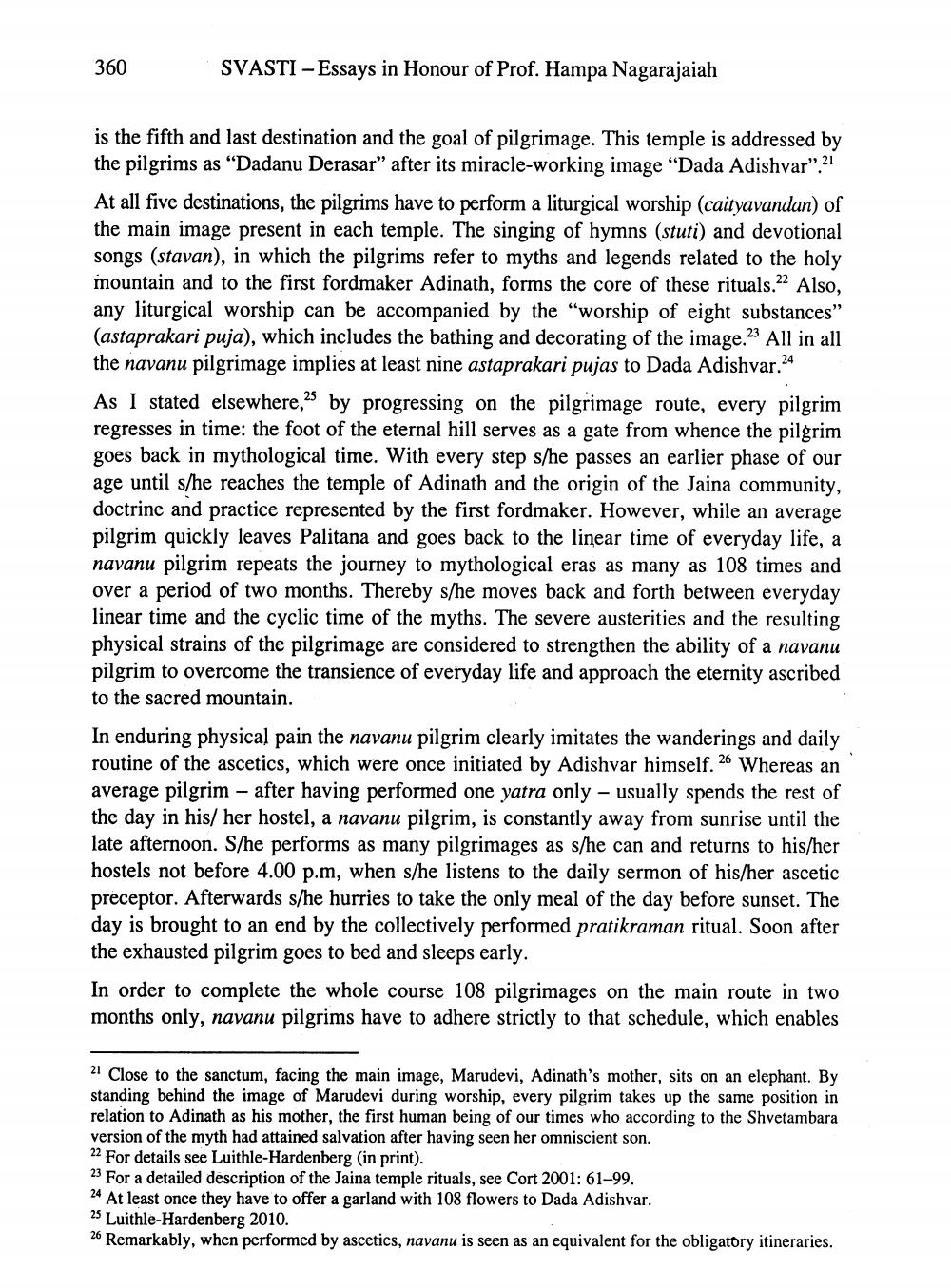________________
360
SVASTI -Essays in Honour of Prof. Hampa Nagarajaiah
is the fifth and last destination and the goal of pilgrimage. This temple is addressed by the pilgrims as "Dadanu Derasar" after its miracle-working image "Dada Adishvar" 21 At all five destinations, the pilgrims have to perform a liturgical worship (caityavandan) of the main image present in each temple. The singing of hymns (stuti) and devotional songs (stavan), in which the pilgrims refer to myths and legends related to the holy mountain and to the first fordmaker Adinath, forms the core of these rituals.22 Also, any liturgical worship can be accompanied by the "worship of eight substances" (astaprakari puja), which includes the bathing and decorating of the image. 23 All in all the navanu pilgrimage implies at least nine astaprakari pujas to Dada Adishvar.24 As I stated elsewhere,2 by progressing on the pilgrimage route, every pilgrim regresses in time: the foot of the eternal hill serves as a gate from whence the pilgrim goes back in mythological time. With every step s/he passes an earlier phase of our age until s/he reaches the temple of Adinath and the origin of the Jaina community, doctrine and practice represented by the first fordmaker. However, while an average pilgrim quickly leaves Palitana and goes back to the linear time of everyday life, a navanu pilgrim repeats the journey to mythological eras as many as 108 times and over a period of two months. Thereby s/he moves back and forth between everyday linear time and the cyclic time of the myths. The severe austerities and the resulting physical strains of the pilgrimage are considered to strengthen the ability of a navanu pilgrim to overcome the transience of everyday life and approach the eternity ascribed to the sacred mountain. In enduring physical pain the navanu pilgrim clearly imitates the wanderings and daily routine of the ascetics, which were once initiated by Adishvar himself. 26 Whereas an average pilgrim - after having performed one yatra only - usually spends the rest of the day in his/ her hostel, a navanu pilgrim, is constantly away from sunrise until the late afternoon. S/he performs as many pilgrimages as s/he can and returns to his/her hostels not before 4.00 p.m, when s/he listens to the daily sermon of his/her ascetic preceptor. Afterwards s/he hurries to take the only meal of the day before sunset. The day is brought to an end by the collectively performed pratikraman ritual. Soon after the exhausted pilgrim goes to bed and sleeps early. In order to complete the whole course 108 pilgrimages on the main route in two months only, navanu pilgrims have to adhere strictly to that schedule, which enables
21 Close to the sanctum, facing the main image, Marudevi, Adinath's mother, sits on an elephant. By standing behind the image of Marudevi during worship, every pilgrim takes up the same position in relation to Adinath as his mother, the first human being of our times who according to the Shvetambara version of the myth had attained salvation after having seen her omniscient son. 22 For details see Luithle-Hardenberg (in print). 23 For a detailed description of the Jaina temple rituals, see Cort 2001: 61-99. 24 At least once they have to offer a garland with 108 flowers to Dada Adishvar. 25 Luithle-Hardenberg 2010. 26 Remarkably, when performed by ascetics, navanu is seen as an equivalent for the obligatory itineraries.




